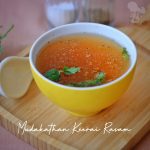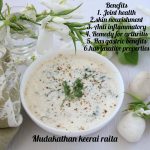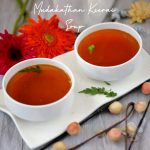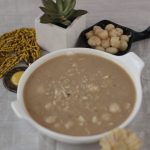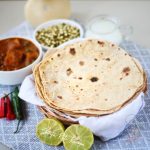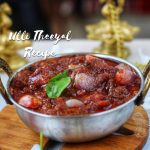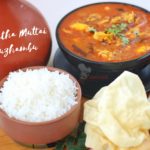Indulging in a bowl of Mudakathan keerai kuzhambu is not just a gastronomic delight but also a journey into the world of holistic well-being. The esteemed Mudakathan keerai, with its potential anti-inflammatory and antioxidant properties, imparts not only its vibrant green hue but also its potential health benefits to this delectable curry.
1. Mudakathan Keerai Kuzhambu
2. An Introduction On South India's Leafy Green Cooking Culture
3. A Specific View On Mudakathan Keerai Kuzhambu
4. The Origin And Culinary History of Mudakathan keerai kuzhambu In South Indian Cuisine
5. Exclusive Health Benefits Of Mudakathan Keerai
6. Climatic Conditions To Grow Mudakathan Keerai
7. Ingredients Required To Make Mudakathan Keerai Kuzhambu
8. Step Wise Directions To Make Mudakathan keerai Kuzhambu
9. Nutritional Value
10. Make Ahead Tips
11. Mudakathan Keerai Kuzhambu In A Nutshell
12. A Typical Tamil Nadu Lunch menu That Includes Mudakathan Keerai Kuzhambu
13. Takeaway
Mudakathan keerai kuzhambu, a traditional dish, that delights both the palate and the senses, showcases the rich flavors and health benefits of this remarkable leafy green. Its vibrant colors, aromatic spices, and unique blend of tangy and earthy notes create a symphony of taste that leaves a lasting impression. A testament to the culinary heritage and wisdom of our ancestors, this traditional dish not only tantalizes the taste buds but also nourishes the body with its abundant nutritional profile. Mudakathan keerai kuzhambu truly exemplifies the artistry and goodness of South Indian cuisine.
An Introduction On South India's Leafy Green Cooking Culture:
South India's leafy green cooking culture is a vibrant tapestry woven with flavors, colors, and nutritional goodness. It is a culinary tradition that celebrates the abundant variety of leafy greens found in the region, showcasing their unique tastes, textures, and health benefits. Leafy greens, commonly known as keerai in the local language Tamil, are an integral part of the South Indian diet, adding not only taste and visual appeal but also an array of vitamins, minerals, and antioxidants.
South Indian cuisine is known for its diverse range of leafy greens, including spinach, amaranth, fenugreek, drumstick leaves, colocasia leaves, and many more. These greens are treasured for their distinct flavors, which range from earthy and slightly bitter to mildly sweet and tangy. Each green brings its own characteristic nuances to a dish, making it a delightful journey of taste exploration.
The art of cooking leafy greens in South India goes beyond mere sustenance. It is a reflection of a cultural heritage deeply rooted in the land's agricultural practices and the wisdom passed down through generations. The traditional cooking methods, the usage of various utensils and various recipes highlight the importance of balance, harmony, and holistic well-being. Incorporating different types of greens in the daily cooking is inevitable in South Indian cuisine.
In South Indian leafy green cooking, freshness is paramount. The greens are often sourced from local markets or even grown in terrace gardens, hand picked instantly from backyards, ensuring their optimum flavor and nutritional value. They are meticulously cleaned, sometimes blanched, and then skillfully incorporated into a variety of dishes, including stir-fries, stews, soups, gravies, and chutneys.
One of the distinctive aspects of South Indian leafy green cooking is the skillful use of spices and seasoning. Mustard seeds, cumin, turmeric, fenu greek, curry leaves, asafoetida (mostly solid) dried red chilies are commonly employed to enhance the natural flavors of the greens, creating a symphony of tastes that is both invigorating and comforting.
Beyond the tantalizing flavors, South Indian leafy green cooking is deeply rooted in the principles of holistic health. The greens are known for their rich nutritional profiles, being excellent sources of dietary fiber, vitamins A, C, and K, iron, calcium, and antioxidants. They are revered for their cleansing and detoxifying properties, aiding digestion, boosting immunity, and promoting overall well-being.
The leafy green cooking culture of South India is a true testament to the region's culinary prowess, knowledge about local vegetation and crops and its deep connection to nature. It is a celebration of diversity, sustainability, and the harmonious integration of taste and health. Whether enjoyed as a standalone dish or as a flavorful accompaniment to rice or bread, South Indian leafy green preparations enchant the senses and nourish both body and soul.
A Specific View On Mudakathan Keerai Kuzhambu:
Mudakathan keerai kuzhambu is a traditional South Indian curry, that features the unique flavors and nutritional benefits of Mudakathan keerai (Balloon vine or Heart-leaf moon seed). This kuzhambu is a delightful blend of tangy, spicy, and earthy flavors that create a satisfying and aromatic dish. It is an age old remedial recipe cooked commonly at all house holds to alleviate knee joint pain.
To prepare Mudakathan keerai kuzhambu, the first step is to clean and wash the Mudakathan keerai leaves thoroughly. The leaves are then finely chopped or ground, depending on personal preference.
In a traditional South Indian style, the kuzhambu base is prepared by sautéing mustard seeds, cumin seeds, fenu greek seeds, dried red chilies, and curry leaves in hot oil. This tempering is followed by the addition of onions, garlic, and sometimes grated coconut for extra richness.
Once the onions turn golden brown, tamarind pulp is added to the mixture, providing the characteristic tanginess. To balance the flavors, a blend of aromatic spices such as turmeric, coriander, and chili powder is added. The chopped or sauteed Mudakathan keerai is then incorporated into the mixture.
To enhance the taste and thickness of the kuzhambu, some recipes call for the addition of cooked lentils or dal. This not only adds creaminess but also boosts the protein content of the dish. The kuzhambu is typically simmered on low heat until the flavors meld together, and the Mudakathan keerai is cooked to perfection.
Mudakathan keerai kuzhambu is often served hot with steamed rice, accompanied by a side of papad or crispy fried vegetables. The flavors deepen and develop further when allowed to sit for some time, making it a popular choice for leftovers or packed lunches.
Apart from its tantalizing taste, Mudakathan keerai kuzhambu is celebrated for its potential health benefits. Mudakathan keerai is believed to possess antioxidant, anti-inflammatory, and hepato (liver) protective properties. It is also considered beneficial for joint health and may aid in alleviating conditions like rheumatism and arthritis.
Mudakathan keerai kuzhambu is a testament to the rich culinary heritage of South India. Its distinctive flavors, combined with the potential health benefits of Mudakathan keerai, make it a flavorful and nutritious addition to the South Indian culinary repertoire.
The Origin And Culinary History of Mudakathan keerai kuzhambu In South Indian Cuisine:
The origin and culinary history of Mudakathan keerai kuzhambu in South Indian cuisine can be traced back to the traditional cooking practices and regional culinary heritage of the region. South Indian cuisine has a rich history spanning centuries, shaped by the cultural influences, agricultural practices, and indigenous ingredients of the region.
Mudakathan keerai, the key ingredient in Mudakathan keerai kuzhambu, is a leafy green native to South India. It has been traditionally used in Ayurveda and Siddha medicinal practices for its potential health benefits. Over time, it found its way into South Indian culinary preparations, ike soup, rasam pachadi, thuvayal and kuzhambu.
Kuzhambu, in general, is a popular South Indian curry characterized by its tangy and spicy flavors. It has been an integral part of South Indian cuisine for generations and has evolved to incorporate a wide range of ingredients, including different types of leafy greens like Mudakathan keerai.
The exact origin and specific timeline of Mudakathan keerai kuzhambu's inclusion in South Indian cuisine may be challenging to pinpoint, as many traditional dishes have been passed down orally through generations. However, it is believed that the culinary history of Mudakathan keerai kuzhambu is deeply rooted in the agrarian lifestyle and traditional cooking practices of the region.
South India has a strong agricultural tradition, and the use of locally grown ingredients, including leafy greens, is highly valued. Mudakathan keerai, being a native green, would have been readily available to the people in the region, making it a natural choice for inclusion in their culinary repertoire.
The cooking methods and flavor profiles of South Indian cuisine have evolved over time, influenced by various factors such as regional preferences, cultural exchanges, and the availability of ingredients. The culinary history of South Indian cuisine is a tapestry of traditions passed down from generation to generation, adapting to changing times while preserving the essence of the regional flavors.
Mudakathan keerai kuzhambu, with its unique combination of Mudakathan keerai, tamarind, spices, and other ingredients, reflects the ingenuity and resourcefulness of South Indian cooks in creating flavorful and nutritious dishes. It continues to be cherished as a traditional preparation, showcasing the culinary heritage and culinary wisdom of South India especially its villages.
Mudakathan keerai kuzhambu stands as a testament to the enduring culinary traditions and the deep connection between nature, wellness, habitat and gastronomy in South Indian cuisine.
Exclusive Health Benefits Of Mudakathan Keerai:
Anti-inflammatory properties: Mudakathan keerai is believed to possess anti-inflammatory properties, which may help reduce inflammation in the body. This is particularly beneficial for individuals suffering from inflammatory conditions such as arthritis or joint pain.
Antioxidant activity: Mudakathan keerai is rich in antioxidants, which help protect the body against oxidative stress caused by harmful free radicals. Antioxidants are known to support overall health and may help reduce the risk of chronic diseases.
Joint health: In traditional medicine, Mudakathan keerai is often used to support joint health. It is believed to have a cooling effect on the body and is commonly consumed to alleviate joint pain, inflammation, and swelling.
Digestive health: It is considered beneficial for digestive health. It is believed to aid in digestion, promote healthy bowel movements, and alleviate digestive issues such as constipation and bloating.
Detoxification: Mudakathan keerai is often used in traditional detoxification practices. It is believed to have detoxifying properties, helping to cleanse the body and eliminate toxins.
Potential antimicrobial effects: Some studies have suggested that it possesses antimicrobial properties, which may help inhibit the growth of certain bacteria and fungi. However, further research is needed to better understand and validate these potential effects.
Climatic Conditions To Grow Mudakathan Keerai:
Soil: Mudakathan keerai prefers well-drained, fertile soil. It can grow in a wide range of soil types, including loamy, sandy, or clayey soils. The soil should be rich in organic matter and have good moisture-holding capacity.
Humidity: It thrives in high humidity conditions. It prefers a humid environment with moisture levels ranging from 50% to 80%. The humid conditions aid in the growth and lushness of the leaves.
Temperature: This keerai prefers a warm environment and cannot tolerate frost or extremely low temperatures. It thrives in temperatures ranging from 20°C (68°F) to 35°C (95°F) approximately.
Sunlight: Mudakathan keerai requires an ample amount of sunlight to grow. It flourishes in areas with full or partial sun exposure. It is best to provide it with at least 4 to 6 hours of direct sunlight daily.
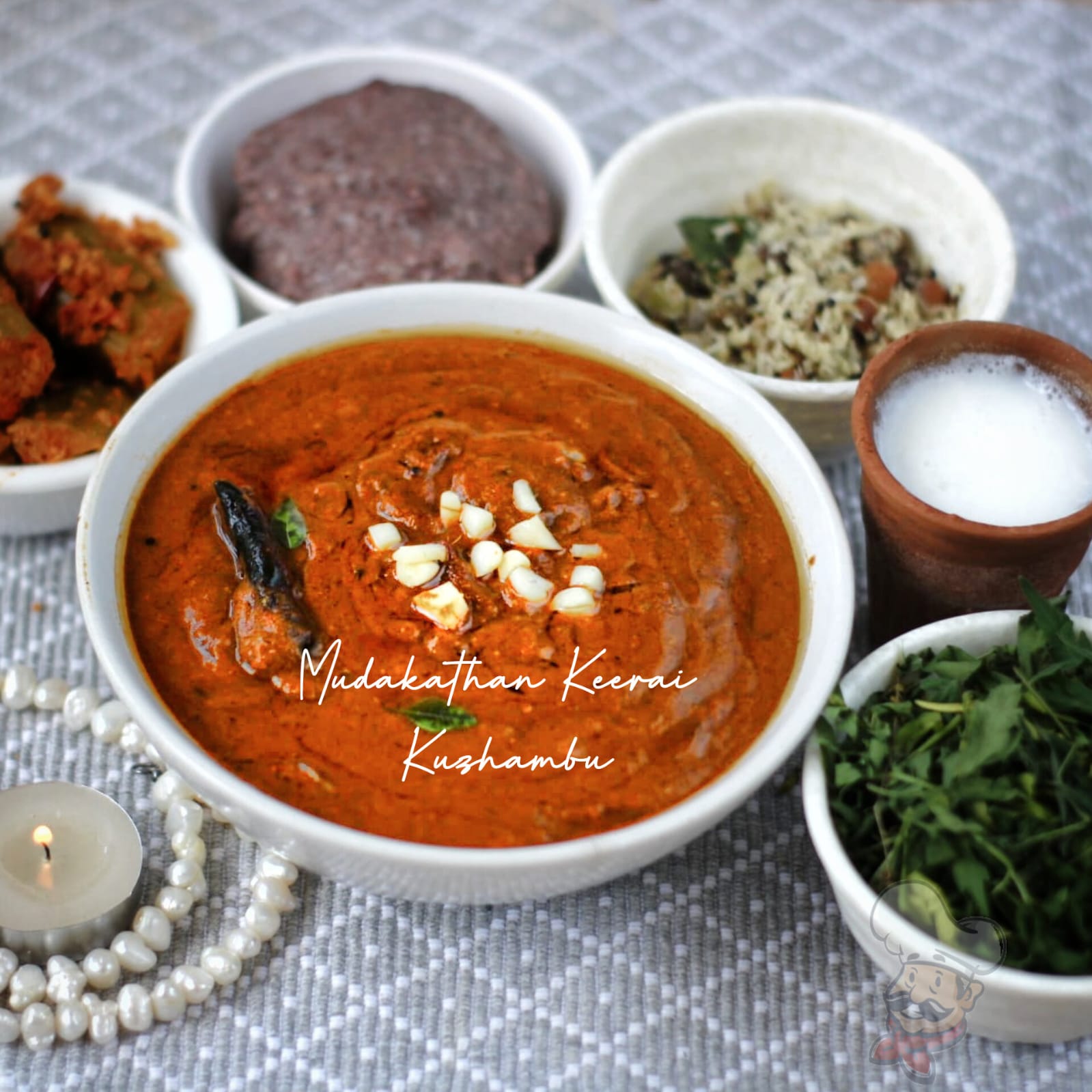
Needed Ingredients To Make Mudakathan Keerai Kuzhambu:
Step Wise Directions To Make Mudakathan Keerai Kuzhambu:
Take a tiny ball of tamarind and soak it in hot water and keep aside. When it cools down gently squeeze the pulp and strain the tamarind water in a cup and keep it.
Clean the mudakathan keerai and get rid of the tiny stalks from the keerai and wash well. Peel off the skin from the shallots and garlic and chop the tomato.
Heat a saucepan and tip in a little oil and scatter some peppercorns and cumin seeds. Add a quarter cup of urad dal along with some dried red chilies. Stir in low flame and throw in some curry leaves and add a pinch of asafoetida powder. When the whole mixture gets roasted up, just lower the flame and change the ingredients into a vessel.
Place the pan again in the stove and tip in a little oil. Add a cup of mudakathan keerai and saute well until it turns aromatic. Transfer it to a plate and heat the saucepan again. Add all the roasted ingredients including this keerai to a blender and blend it into a smooth paste and keep aside.
Heat the saucepan and tip in three tablespoons of sesame oil and when it is heated scatter some mustard seeds to it. Add the measured quantities of fenugreek seeds, asafoetida powder and curry leaves and when it splutters just add the measured quantities of garlic cloves and shallots to it. Stir everything in low flame and when the onion turns translucent, just plop in the tomatoes. When it begins to soften, sprinkle the required amount of rock salt with a nice stir.
Add the measured quantities of red chili, coriander and turmeric powders and add the spice and keerai paste into the sauce pan with a nice stir. Let it saute for a minute and now add two cups of water approximately. When it starts to boil, add the tamarind water and alter the flame to high mode. Let it boil for about seven to ten minutes approximately. Keep stirring now and then and when it thickens, just sprinkle a teaspoon of jaggery and when the oil starts to separate at the sides, just turn off the flame. Now the mudakathan keerai kuzhambu is ready to serve.
Serve it hot with a cup of rice, a little ghee and potato fry.
Make Ahead Tips:
Dos:
Do thoroughly clean the Mudakathan keerai leaves before using them by removing the leaves from the stalk. Remove any dirt, debris, or damaged leaves.
Do follow the recipe instructions carefully, including the sequence of adding ingredients and spices, to achieve the desired flavors and consistency.
Do use fresh and high-quality ingredients for the best taste and nutritional value.
Do adjust the spice levels according to your preference. You can increase or decrease the amount of chili powder or other spices to suit your taste.
Do taste the mudakathan keerai kuzhambu as it simmers and adjust the seasonings if needed. You can add more tamarind pulp, salt, or spices to balance the flavors.
Do let the kuzhambu simmer on low heat for sufficient time to allow the flavors to develop and the Mudakathan keerai to cook properly.
Don'ts:
Don't overcook the Mudakathan keerai. Overcooking can result in loss of nutrients and a mushy texture. It is best to cook it until it is wilted and tender, but still retains some texture and color.
Don't forget to adjust the consistency of the kuzhambu. If it is too thick, you can add a little water to achieve the desired consistency. If it is too thin, you can simmer it for a bit longer to thicken it.
Don't add too much tamarind pulp at once. Start with a moderate amount and adjust according to your taste preferences. Adding too much tamarind can overpower the flavors of the dish.
Don't skip the tempering process at the beginning. The tempering of mustard seeds, cumin seeds, and other spices adds depth and aroma to the kuzhambu.
Don't rush the cooking process. Allow the flavors to develop by simmering the mudakathna keerai kuzhambu on low heat for a sufficient amount of time. This helps the ingredients meld together and enhances the taste.
Don't store the kuzhambu in the refrigerator for a long period. If you have leftovers, ensure that you transfer them to an earthern container like a "man satti" or a terracotta vessel and leave untouched in a dark corner of the kitchen to maintain freshness and prevent spoilage. Also preparing the kuzhambu in mansatti or kalsatti is a wise choice.
These tips can help you in making a delicious and well-balanced Mudakathan keerai kuzhambu. Feel free to adjust them based on your personal taste preferences and dietary needs.
Mudakathan Keerai Kuzhambu In A Nutshell:
Color: The color of Mudakathan keerai kuzhambu can vary depending on the other ingredients used, but it is generally a deep greenish-brown color or light brown color due to the presence of Mudakathan keerai and the spices used in the preparation.
Texture: Mudakathan keerai kuzhambu has a thick and slightly grainy texture due to the presence of ground Mudakathan keerai leaves and other ingredients. It is typically a smooth curry with occasional small bits of Mudakathan keerai throughout.
Flavor: Mudakathan keerai kuzhambu has a complex flavor profile. It is tangy, slightly spicy, and has earthy undertones. The combination of tamarind, spices, and Mudakathan keerai imparts a unique and distinct flavor to the dish.
Consistency: The consistency of Mudakathan keerai kuzhambu can vary based on personal preference and regional variations. It is typically a medium-thick curry with a pouring consistency. However, you can adjust the consistency by adding more water or simmering longer to thicken it if desired.
Smell: Mudakathan keerai kuzhambu has an aromatic smell due to the tempering of spices and the cooking process. It emits a pleasant aroma of spices, tamarind, and the inherent fragrance of Mudakathan keerai.
Taste: Mudakathan keerai kuzhambu has a well-balanced taste. It is tangy, slightly spicy, and has a hint of bitterness from Mudakathan keerai. The combination of flavors creates a unique and satisfying taste experience.
Thus, Mudakathan keerai kuzhambu offers a delightful combination of flavors, textures, and aromas that are characteristic of South Indian cuisine. The dish showcases the natural and earthy taste of Mudakathan keerai while harmonizing with the spices and other ingredients used in its preparation.
A Typical Tamil Nadu Lunch menu That Includes Mudakathan Keerai Kuzhambu:
Main Dishes:
Steamed Rice: A staple component of the meal.
Mudakathan Keerai Kuzhambu: A flavorful curry made with Mudakathan keerai, tamarind, and spices.
Sambar: A lentil-based vegetable stew, typically made with a combination of toor dal (split pigeon peas), vegetables, and a blend of spices.
Rasam: A tangy and spicy tomato-based soup made with tamarind juice, pepper, and other aromatic spices.
Accompaniments:
5. Poriyal: A dry vegetable stir-fry, such as beans poriyal or carrot poriyal, made with sautéed vegetables, coconut, and spices.
Appalam/Papad: Thin, crispy lentil wafers served as a crunchy accompaniment.
Moru Kootu: A curd-based curry made with buttermilk, coconut, and tempered with mustard seeds and curry leaves. It provides a cooling element to balance the flavors.
Paruppu/Dal: A simple lentil dish, often made with toor dal, tempered with ghee, mustard seeds, and curry leaves.
Thayir/Curd: Fresh homemade yogurt, which is served as a cooling and soothing element alongside the meal.
Pickle: A tangy and spicy condiment, such as mango pickle or lime pickle, to add an extra burst of flavor.
Payasam/Kheer: A sweet dessert made with ingredients like rice, vermicelli, or lentils, cooked in milk and flavored with cardamom and nuts.
Takeaway:
Mudakathan keerai kuzhambu is a culinary gem from the authentic Tamil Nadu cuisine, cherished for its therapeutic properties and tantalizing flavors. This traditional dish showcases the rich heritage and wisdom of generations past, as it combines the goodness of Mudakathan keerai with a harmonious blend of spices and tangy tamarind.With each spoonful, you are transported to the sun-kissed landscapes of Tamil Nadu, where the warmth of the region's climate infuses the dish with an earthy aroma and delightful flavors. The tanginess of tamarind dances on your taste buds, perfectly complementing the subtle bitterness of Mudakathan keerai, while the medley of spices adds depth and complexity to the experience.Beyond its exceptional taste, Mudakathan keerai kuzhambu offers a treasure trove of wellness. It is believed to support joint health, aid digestion, and provide a nourishing dose of essential nutrients. As you savor this therapeutic delight, you can appreciate the wisdom passed down through generations, recognizing the profound connection between food and healing in Tamil Nadu's authentic culinary traditions.
So, let the healing powers of Mudakathan keerai kuzhambu envelop you, transporting you to a realm where taste and wellness intertwine. Embrace this gift from Tamil Nadu's culinary heritage, relishing in the profound nourishment it provides, and celebrating the rich tapestry of flavors that have stood the test of time.
Faqs:
Q1: What is Mudakathan keerai kuzhambu?
A1: Mudakathan keerai kuzhambu is a traditional South Indian curry made with Mudakathan keerai (Balloon vine or Heart-leaf moonseed) as the key ingredient. It is a flavorful and tangy curry known for its unique taste and potential health benefits.
Q2: How is Mudakathan keerai kuzhambu prepared?
A2: The preparation of Mudakathan keerai kuzhambu typically involves sautéing spices like mustard seeds, cumin seeds, and fenugreek seeds in oil. Onions, garlic, and sometimes grated coconut are added for flavor. Tamarind pulp is incorporated for tanginess, and a blend of spices such as turmeric, coriander, and chili powder is added. Mudakathan keerai is then added to the mixture, and the kuzhambu is simmered until the flavors meld together.
Q3: Can Mudakathan Keerai Kuzhambu be stored and reheated?
A3: It can be stored for a few hours in the refrigerator and reheated if necessary but it is always advisable to eat keerai based dishes within the same day if you wish to absorb its nutrients to the fullest and keep your digestive system intact.
Ingredients
Directions
Take a tiny ball of tamarind and soak it in hot water and keep aside. When it cools down gently squeeze the pulp and strain the tamarind water in a cup and keep it.
Clean the mudakathan keerai and get rid of the tiny stalks from the keerai and wash well. Peel off the skin from the shallots and garlic and chop the tomato.
Heat a saucepan and tip in a little oil and scatter some peppercorns and cumin seeds. Add a quarter cup of urad dal along with some dried red chilies. Stir in low flame and throw in some curry leaves and add a pinch of asafoetida powder. When the whole mixture gets roasted up, just lower the flame and change the ingredients into a vessel.
Place the pan again in the stove and tip in a little oil. Add a cup of mudakathan keerai and saute well until it turns aromatic. Transfer it to a plate and heat the saucepan again. Add all the roasted ingredients including this keerai to a blender and blend it into a smooth paste and keep aside.
Heat the saucepan and tip in three tablespoons of sesame oil and when it is heated scatter some mustard seeds to it. Add the measured quantities of fenugreek seeds, asafoetida powder and curry leaves and when it splutters just add the measured quantities of garlic cloves and shallots to it. Stir everything in low flame and when the onion turns translucent, just plop in the tomatoes. When it begins to soften, sprinkle the required amount of rock salt with a nice stir.
Add the measured quantities of red chili, coriander and turmeric powders and add the spice and keerai paste into the sauce pan with a nice stir. Let it saute for a minute and now add two cups of water approximately. When it starts to boil, add the tamarind water and alter the flame to high mode. Let it boil for about seven to ten minutes approximately. Keep stirring now and then and when it thickens, just sprinkle a teaspoon of jaggery and when the oil starts to separate at the sides, just turn off the flame. Now the mudakathan keerai kuzhambu is ready to serve.
Serve it hot with a cup of rice, a little ghee and potato fry.

